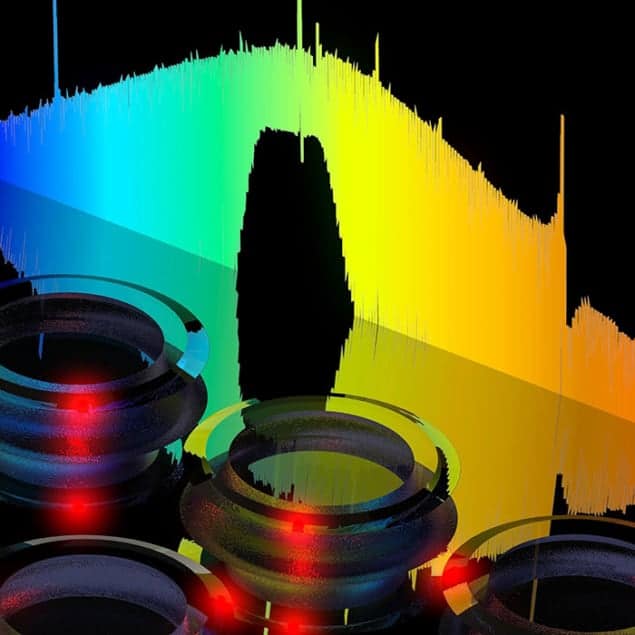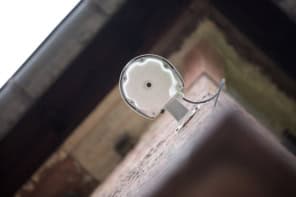
A new spectrometer-on-a-chip that employs two frequency combs has been unveiled by physicists at Caltech in the US. The precision spectroscopy system is based on pulsed lasers and uses a technique known as dual-comb spectroscopy. This makes it one thousand times more precise and nearly one million times faster than the standard instruments used today. Based on a millimetre-sized silicon chip, the device is an important step towards the creation of portable devices capable of the real-time and precise characterization of the chemical composition of biological or environmental samples. Experts say such devices could have a number of medical and military applications.
Optical spectroscopy is a powerful tool that is used in a wide range of sciences – including astrophysics, biology and chemistry – to determine the chemical composition of unknown specimens. It uses the fact that the frequencies at which a substance will absorb light, known as its absorption spectrum, can serve as a “fingerprint” that reveals which atoms and molecules are in the substance. The accuracy of these chemical fingerprints depends on how precisely a spectrometer can resolve these absorption frequencies from another.
The new spectrometer-on-a-chip was created by Kerry Vahala and colleagues, and it offers a resolution that is about a thousand times better than a conventional grating spectrometer. “Spectroscopists, if you can give them more resolution – they will always take it,” Vahala says.
Wideband pulses
The dual-comb spectroscopy technique was first demonstrated about ten years ago and some implementations have already achieved resolutions 10 million times better than conventional spectrometers. It uses two lasers known as frequency combs that each emit femtosecond-long pulses. Unlike standard lasers that emit in a narrow frequency band, frequency combs have a wide frequency spectrum consisting of many hundreds or thousands of narrow, equally spaced peaks resembling the teeth of a comb. This means the comb is capable of investigating multiple absorption lines simultaneously.
One comb is tuned such that the spacing between its teeth is slightly greater than the spacing in the other comb. The light from the first comb illuminates the material, which absorbs specific wavelengths depending on its chemical composition. When the resulting light is mixed with the second comb’s light, the output includes a radio-frequency envelope signal equal to the frequency difference between the two combs. This envelope is a beat frequency similar to that produced by two guitar strings slightly out of tune with another.
One cycle of this microsecond-scale envelope contains information about the entire absorption spectrum of the sample. Thus, by electronically processing one cycle of this signal, the spectrum can be produced in just microseconds. In contrast, spectrometers that use a diffraction grating take about one minute to acquire the same information.
Race to miniaturize
Although table-sized frequency combs have existed for more than a decade, the effort to shrink these systems to chip-scale has intensified in the past two years. “There’s been a kind of a race to make these things,” says Vahala, whose group is one of a handful in the world that have successfully made millimetre-sized combs.
The chip they produced houses two frequency combs made from two glass rings 3 mm in diameter, known as microresonators. A different laser directs light into the cavity of each glass ring. Each ring amplifies its light to create pulses known as solitons that make up the frequency comb. The team verified the accuracy of the chip by measuring the spectrum of hydrogen cyanide, which has absorption lines that match the frequency range generated by the two combs. Vahala says that the group is working on expanding the number of frequencies their tiny combs can generate.
Research funding agencies like the Defense Advanced Research Projects Agency in the US have been “investing heavily” in these high-precision spectroscopy techniques, according to Peter Delfyett, a frequency comb expert at the University of Central Florida who was not involved in developing the dual-comb chip. Chip-based technologies are of particular interest because miniature systems could be useful in a variety of different tasks. A chip could be installed on a drone for remote environmental monitoring, for example, or used in a breathalyzer to diagnose illness. They could even lead to applications that “we don’t even know about yet,” Delfyett says.
While technical details of the spectrometer-on-a-chip need to be improved, Delfyett predicts that this technology will be ripe for commercialization in less than a decade. “I’m very encouraged by the tremendous amount of effort the scientific community is putting into miniaturizing these comb sources,” he says.
The research is described in Science.
- The basics of how a frequency comb works are explained in this video of Paul Williams of the National Institute of Standards and Technology: “What is a frequency comb?”.



